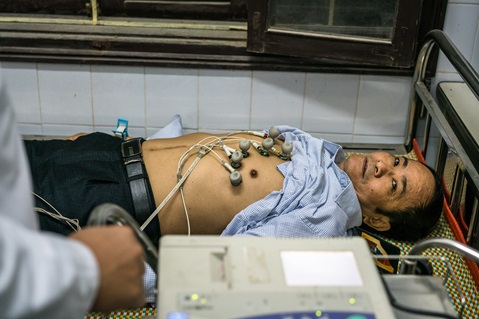Show Cardiovascular diseases (CVDs) are the leading cause of death globally, taking an estimated 17.9 million lives each year. CVDs are a group of disorders of the heart and blood vessels and include coronary heart disease, cerebrovascular disease, rheumatic heart disease and other conditions. More than four out of five CVD deaths are due to heart attacks and strokes, and one third of these deaths occur prematurely in people under 70 years of age. The most important behavioural risk factors of heart disease and stroke are unhealthy diet, physical inactivity, tobacco use and harmful use of alcohol. The effects of behavioural risk factors may show up in individuals as raised blood pressure, raised blood glucose, raised blood lipids, and overweight and obesity. These “intermediate risks factors” can be measured in primary care facilities and indicate an increased risk of heart attack, stroke, heart failure and other complications. Cessation of tobacco use, reduction of salt in the diet, eating more fruit and vegetables, regular physical activity and avoiding harmful use of alcohol have been shown to reduce the risk of cardiovascular disease. Health policies that create conducive environments for making healthy choices affordable and available are essential for motivating people to adopt and sustain healthy behaviours. Identifying those at highest risk of CVDs and ensuring they receive appropriate treatment can prevent premature deaths. Access to noncommunicable disease medicines and basic health technologies in all primary health care facilities is essential to ensure that those in need receive treatment and counselling. Heart attack and stroke Often, there are no symptoms of the underlying disease of the blood vessels. A heart attack or stroke may be the first sign of underlying disease. Symptoms of a heart attack include:
In addition the person may experience difficulty in breathing or shortness of breath; nausea or vomiting; light-headedness or faintness; a cold sweat; and turning pale. Women are more likely than men to have shortness of breath, nausea, vomiting, and back or jaw pain. The most common symptom of a stroke is sudden weakness of the face, arm, or leg, most often on one side of the body. Other symptoms include sudden onset of:
People experiencing these symptoms should seek medical care immediately. Rheumatic heart disease Symptoms of rheumatic heart disease include: shortness of breath, fatigue, irregular heartbeats, chest pain and fainting. Symptoms of rheumatic fever (which can cause rheumatic heart disease if not treated) include: fever, pain and swelling of the joints, nausea, stomach cramps and vomiting. WHO supports governments to prevent, manage and monitor CVDs by developing global strategies to reduce the incidence, morbidity and mortality of these diseases. These strategies include reducing risk factors, developing standards of care, enhancing health system capacity to care for patients with CVD, and monitoring disease patterns and trends to inform national and global actions. The risk factors for CVD include behaviours such as tobacco use, an unhealthy diet, harmful use of alcohol and inadequate physical activity. They also include physiological factors, including high blood pressure (hypertension), high blood cholesterol and high blood sugar or glucose, which are linked to underlying social determinants and drivers such as ageing, income and urbanization.
17.9 millionpeople die each yearfrom CVDs, an estimated 32% of all deaths worldwide. Fact sheet >75%of CVD deaths occur in low- and middle-income countries. 85%of all CVD deaths are due to heart attacks and strokes. How does hypertensive cardiovascular disease cause death?Without appropriate blood pressure control, the heart can weaken over time and heart failure may develop. High blood pressure also leads to thickening of the blood vessel walls. When combined with cholesterol deposits in the blood vessels, the risk of heart attack and stroke increases.
How does arteriosclerosis cause death?If a plaque bursts, a blood clots may form that may block the artery completely or travel to other parts of the body. Blockages, either complete or incomplete, can cause complications, including heart attack, stroke, vascular dementia, erectile dysfunction, or limb loss. Atherosclerosis can cause death and disability.
What is the most common cause of death in hypertensive patients?Having hypertension puts you at risk for heart disease and stroke, which are leading causes of death in the United States.
What cardiovascular disease causes the most deaths?Heart Disease in the United States
Heart disease is the leading cause of death for men, women, and people of most racial and ethnic groups in the United States.
|

Advertising
LATEST NEWS
Advertising
Populer
Advertising
About

Copyright © 2024 membukakan Inc.











